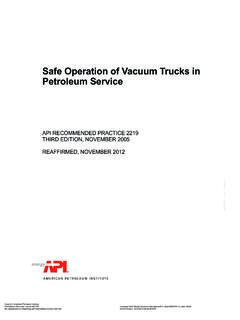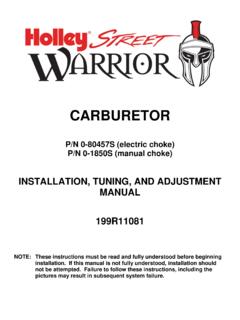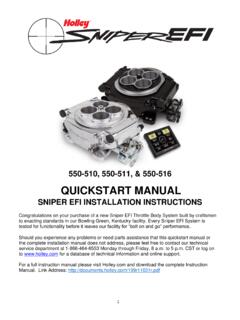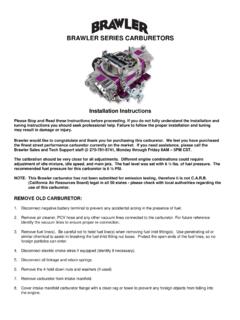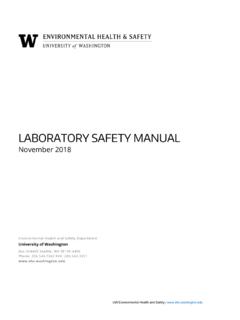Transcription of Safe Operation of Vacuum Trucks in Petroleum Service
1 safe Operation of Vacuum Trucks in Petroleum ServiceAPI RECOMMENDED PRACTICE 2219 THIRD EDITION, NOVEMBER 2005 REAFFIRMED, NOVEMBER 2012 Copyright American Petroleum Institute Provided by IHS under license with API Licensee=Shell Global Solutions International Main/5924979112, User=ElliottNot for Resale, 12/30/2013 09:55:43 MSTNo reproduction or networking permitted without license from IHS--``,,```,`,,,`,,`````,,,,``,``-`-`,, `,,`,`,,`---Copyright American Petroleum Institute Provided by IHS under license with API Licensee=Shell Global Solutions International Main/5924979112, User=ElliottNot for Resale, 12/30/2013 09:55:43 MSTNo reproduction or networking permitted without license from IHS--``,,```,`,,,`,,`````,,,,``,``-`-`,, `,,`,`,,`--- safe Operation of Vacuum Trucks in Petroleum ServiceDownstream SegmentAPI RECOMMENDED PRACTICE 2219 THIRD EDITION, NOVEMBER 2005 REAFFIRMED, NOVEMBER 2012 Copyright American Petroleum Institute Provided by IHS under license with API Licensee=Shell Global Solutions International Main/5924979112, User=ElliottNot for Resale, 12/30/2013 09:55:43 MSTNo reproduction or networking permitted without license from IHS--``,,```,`,,,`,,`````,,,,``,``-`-`,, `,,`,`,,`---SPECIAL NOTESAPI publications necessarily address problems of a general nature.
2 With respect to particular circumstances, local, state, and federal laws and regulations should be API nor any of API's employees, subcontractors, consultants, committees, or other assignees make any warranty or representation, either express or implied, with respect to the accuracy, completeness, or usefulness of the information contained herein, or assume any liability or responsibility for any use, or the results of such use, of any information or process disclosed in this publication. Neither API nor any of API's employees, subcontractors, con-sultants, or other assignees represent that use of this publication would not infringe upon pri-vately owned publications may be used by anyone desiring to do so. Every effort has been made by the Institute to assure the accuracy and reliability of the data contained in them; however, the Institute makes no representation, warranty, or guarantee in connection with this publication and hereby expressly disclaims any liability or responsibility for loss or damage resulting from its use or for the violation of any authorities having jurisdiction with which this publi-cation may publications are published to facilitate the broad availability of proven, sound engineer-ing and operating practices.
3 These publications are not intended to obviate the need for applying sound engineering judgment regarding when and where these publications should be utilized. The formulation and publication of API publications is not intended in any way to inhibit anyone from using any other manufacturer marking equipment or materials in conformance with the marking requirements of an API standard is solely responsible for complying with all the applicable requirements of that standard. API does not represent, warrant, or guarantee that such prod-ucts do in fact conform to the applicable API API nor any of API s employees, subcontractors, consultants, or other assigns make any warranty or representation, either express or implied, with respect to the accuracy, com-pleteness, or utility of the information contained herein, or assume any liability or responsi-bility for any use, or the results of such use, of any information or process disclosed in this publication, or represent that its use would not infringe upon privately owned rights.
4 Classified areas may vary depending on the location, conditions, equipment, and substances involved in any given situation. Users of this recommended practice should consult with the appropriate authorities having of this recommended practice should not rely exclusively on the information con-tained in this document. Sound business, scientific, engineering, and safety judgment should be used in employing the information contained herein. To be used in the Special Notes of any publications related to benzene, and in any health and safety American Petroleum Institute Provided by IHS under license with API Licensee=Shell Global Solutions International Main/5924979112, User=ElliottNot for Resale, 12/30/2013 09:55:43 MSTNo reproduction or networking permitted without license from IHS--``,,```,`,,,`,,`````,,,,``,``-`-`,, `,,`,`,,`---API is not undertaking to meet the duties of employers, manufacturers, or suppliers to warn and properly train and equip their employees, and others exposed, concerning health and safety risks and precautions, nor undertaking their obligations to comply with authorities having concerning safety and health risks and proper precautions with respect to partic-ular materials and conditions should be obtained from the employer, the manufacturer or supplier of that material, or the material safety data applicable.
5 Authorities having jurisdiction should be sites and equipment operations may differ. Users are solely responsible for assessing their specific equipment and premises in determining the appropriateness of applying the recommended practice. At all times users should employ sound business, scientific, engi-neering, and judgment safety when using this recommended is not undertaking to meet the duties of employers, manufacturers, or suppliers to warn and properly train and equip their employees, and others exposed, concerning health and safety risks and precautions, nor undertaking their obligations to comply with authorities having rights reserved. No part of this work may be reproduced, stored in a retrieval system, or transmitted by any means, electronic, mechanical, photocopying, recording, or otherwise, without prior written permission from the publisher.
6 Contact the Publisher, API Publishing services , 1220 L Street, , Washington, 2005 American Petroleum InstituteCopyright American Petroleum Institute Provided by IHS under license with API Licensee=Shell Global Solutions International Main/5924979112, User=ElliottNot for Resale, 12/30/2013 09:55:43 MSTNo reproduction or networking permitted without license from IHS--``,,```,`,,,`,,`````,,,,``,``-`-`,, `,,`,`,,`---FOREWORDThis third edition of safe Operation of Vacuum Trucks in Petroleum Service provides infor-mation concerning the safe Operation of Vacuum Trucks engaged in all aspects of handling flammable and combustible liquids, associated waste water, produced water, sour water, basic sediment and water (BS&W), caustics, spent acids, or other fluids stemming from Petroleum operations .
7 This publication discusses the types of Vacuum pumps and cargo tanks associated with Vacuum truck operations , the common hazards associated with those Vacuum truck operations and representative safe work practices and precautions to help pre-vent accidents and injuries. Appendix G provides brief descriptions of a variety of incidents involving Vacuum Trucks , including offloading into open areas. These may be useful in reviewing specific operating procedures or developing materials for safety meetings or pre-job truck personnel working in Petroleum facilities shall be trained in the safe Operation of the Vacuum equipment, familiar with the hazards of the products being handled and aware of relevant facility permit requirements, safety procedures and emergency response require-ments.
8 It is the responsibility of the Vacuum truck owner and operator to comply with (1) applicable federal, state and local regulations; (2) this recommended practice and (3) facility requirements regarding the safe Operation of Vacuum Trucks ; including, but not limited to, the following items:* Construction, inspection, maintenance and certification of the Vacuum tank. * Selection and safe Operation of the Vacuum truck , Vacuum pump, hoses and accessories. * Regulatory requirements for safe highway Operation of the truck .* Proper transportation, handling and disposal of hazardous materials.* safe Vacuum truck loading, unloading and transport operations within the facility.* Training and qualification of operators and other assigned Vacuum truck the material contained in this document is intended to be consistent with regula-tory requirements, API RP 2219 is not a compliance document.
9 Each user or operator must ensure compliance with all applicable laws and regulations. The United States Department of Transportation (DOT) Code of Federal Regulations, 49 CFR, specifies the minimum requirements for the design, construction, maintenance, testing and Operation of vehicles used for handling and transporting hazardous materials within the United States. Criteria for minimum training and qualifications of drivers and operators are also found in 49 CFR. The Department of Labor, Occupational Safety and Health Administration's (OSHA) require-ments for safety, health and hazard awareness applicable to operators and other personnel working with Vacuum truck operations are found in the Code of Federal Regulations, 29 CFR 1910.
10 U. S. Coast Guard regulations in 33 CFR 154 for bulk transfer of hazardous materials to and from vessels at marine facilities could include certain Vacuum truck transfer procedures contained herein are intended to apply to Vacuum Trucks , skids and trailers used in flammable and combustible liquid Service . These requirements include, but are not limited to, 49 CFR parts - as well as DOT 407 and DOT 412 (formerly des-ignated MC307 and MC312) cargo tank trailers used in Vacuum and transfer operations for handling and transporting flammable and combustible liquids and corrosive materials. Nothing contained in any API publication is to be construed as granting any right, by impli-cation or otherwise, for the manufacture, sale, or use of any method, apparatus, or product covered by letters patent.
